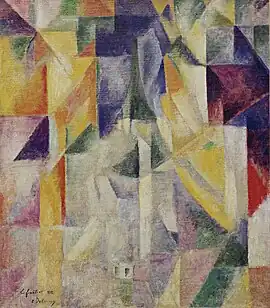| Windows | |
|---|---|
 | |
| Artist | Robert Delaunay |
| Year | 1912 |
| Medium | oil and wax on canvas |
| Dimensions | 79.9 x 70 cm |
| Location | Museum of Modern Art, New York |
Windows is a series of paintings created between 1912 and 1913 by the French painter Robert Delaunay.
Background
Delaunay had begun to present Impressionist paintings in 1904 at the Salon des indépendants. He then incorporated ideas derived from the scientific work of Eugène Chevreul on color, the paintings of Seurat, and then Cézanne, whose work he discovered in 1907 when a major retrospective was dedicated to him.[1]
In 1910, Vassili Kandinsky created the first entirely abstract painting, titled Abstract watercolor, which provoked controversy. He also produced his book Concerning the Spiritual in Art, which outlined his ideas on abstraction, and which Delaunay read with great interest. With the help of his wife Sonia, Robert Delaunay translated it from the original German. He then entered into a correspondence with Kandinsky and with Paul Klee. Modern art then turned toward abstraction, and Guillaume Apollinaire proclaimed in 1912 the birth of a new art : "The new painters paint works where there is no veritable subject."[2]
At this time, Delaunay also conducted much research on colors and the law of simultaneous contrast. With Sonia, he created "simultanism," a technique of finding pictorial harmony through the simultaneous arrangement of colors.[1]
Analysis
Windows take as their point of departure the representation of light and the dynamics of color. Even if these paintings represent exterior reality, they are however considered as abstract entities because the object has lost its importance.[3] Contrary to Kandinsky, Delaunay did not realize his paintings through introspection, but in directly observing nature, as he explained in a letter to August Macke, from 1912 : "One thing is indispensable for me, and that is direct observation, in nature, of its luminous essence. I do not say precisely with a palette in hand (even though I am not against notes taken from immediate nature, I work a lot from nature, as one says vulgarly, 'in front of the subject'). But where I attach great importance is direct observation of the movement of colors. It is only thus that I found the laws of complementary and simultaneous contrast of colors that nourishes the rhythm of vision itself."[4] In refusing all a priori systems, he distances himself from the cerebral approach of artists such as Malévitch or Mondrian.[3]
Paintings in the series
List of some of the paintings:
- Windows, oil on canvas, 35 × 91 cm, Philadelphia Museum of Art
- Windows over the City, oil on canvas, 53 × 207 cm, Museum Folkwang, Essen
- The Window, oil on canvas, 45,8 × 37,5 cm, Musée de Grenoble
- Les Fenêtres simultanées sur la ville, oil on canvas, 46 × 40 cm, Hamburger Kunsthalle
- Windows Open Simultaneously 1st Part, 3rd Motif (1912), Solomon R. Guggenheim Museum, New York
- Simultaneously Open Windows, oil on canvas, 46 × 37,5 cm, Tate galleries, London
- The Windows over the City (First Part, Second Motif), oil ,on card, 39 × 29,6 cm, Sonia Delaunay collection, Paris
- A Window, oil on canvas 110 × 90 cm, Musée National d'Art Moderne, Paris
References
- 1 2 "Futurisme, Rayonnisme, Orphisme". mediation.centrepompidou.fr. Retrieved 2023-12-13.
- ↑ Guillaume Apollinaire, Du sujet dans la peinture moderne, Les Soirées de Paris, No. 1, 1912, p. 2.
- 1 2 Georges Roque, Qu'est-ce que l'art abstrait ?, Paris, Folio essais, 2003, 147–152.
- ↑ Akli, Madalina (2004). "Les mots et les couleurs en mouvement". Paroles gelées. 21 (1). doi:10.5070/PG7211003153. ISSN 1094-7264.